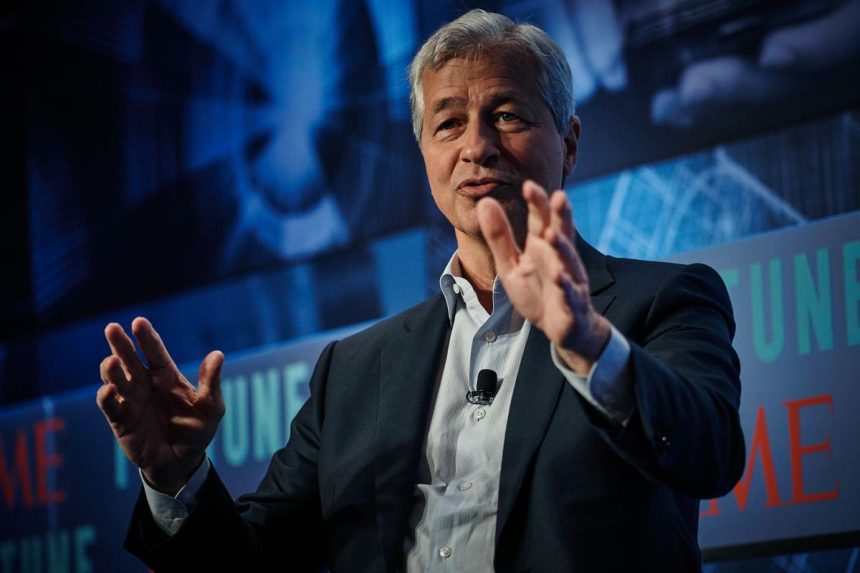Four months ago, JP Morgan Chase CEO Jamie Dimon issued his annual letter to shareholders – and it’s still on my mind. That may be because I spend a lot of time defending stakeholder capitalism, but it’s more than that. It’s because Dimon’s approach could be the new blueprint for American capitalism. And there’s little argument that we need one as America is still reeling from the harmful effects of shareholder primacy, where the rich got richer, and the working class all but disappeared.
Dimon’s letter to his shareholders tells a story especially instructive for those who think Stakeholder Capitalism isn’t capitalism, or at least not true capitalism. Yes, I know some of you hold that view, and I don’t like you any less for that. I just don’t think you’ve put the whole picture together yet. Follow me to the end of this story and see if your views have changed.
In Jamie Dimon’s 2023 annual letter to shareholders (and America at large), he calls himself a red-blooded, patriotic, free-enterprise and free-market capitalist. He is, indeed. He’s also a stakeholder capitalist. He also leads what is by far America’s largest bank and the most stable and successful bank by a large margin.
As he points out, there’s nothing inconsistent with the profit motive in the multifaceted ways his firm uses its capabilities to lift its communities. His letter bears out both claims in spades: JP Morgan Chase is an enormously profitable enterprise that is doing well by doing good.
Let’s reverse that formulation and look at the good-doing first. (This makes sense logically and in terms of the JP Morgan story because the good-doing generates the doing-well part.)
It would be hard to match JP Morgan’s record on social responsibility. Dimon points out that his bank is focused on progressing toward diversity, equity and inclusion (DEI). By year-end, women represented 49% of the firm’s total workforce. Hispanic, Asian and Black representation grew to 21%, 18% and 14%, respectively. In 2022, the number of employees who self-identified as LGBTQ+ increased by 35% yearly, following 50% year-over-year growth in 2021.
In 2022, JP Morgan invested $400 million in over 200 minority-owned businesses. It helped 11,000 Black, Hispanic and Latino families buy homes by expanding its $5,000 Chase Homebuyer Grant program to cover down payments and closing costs. It opened thirteen Community Center branches, often in areas with larger Black, Hispanic and Latino populations.
Dimon singled out what his bank has done in Ohio alone.
It is the second-largest provider of consumer banking in Ohio. As the largest private-sector employer in Columbus, the investment bank employs 20,000 throughout the state. Loans to small businesses in that state totaled over $800 million. That money largely supported the operations and growth of firms that represent the source of most new jobs in America: small to mid-sized businesses.
It serves Ohioans with over two million savings, checking and credit card accounts. Deposits in these accounts total nearly $37 billion.
A closer look points out what this means regarding the larger mission of inclusion. The bank helped Black, Hispanic, and Latino households purchase or refinance a home by loaning $163 million to them as part of its enormous national investment of $30 billion in racial equity. In Ohio, the average JP Morgan salary is $96,000. Its lowest starting wage is $41,000, compared to Ohio’s average salary of $35,000. Those figures exclude additional benefits worth thousands, so total compensation is considerably higher.
All of this is wonderful. It’s all scrupulously consistent with stakeholder capitalism. He could be paying his workers in Ohio the going rate for their jobs, but instead, he pays them enough to give them the quality of life he knows they deserve — he cares about them and their families. In return, they are serving JP Morgan Chase with greater devotion, delivering customer delight that makes higher and higher profits possible.
The recent surge in inflation created a banking crisis. Through its FDIC insurance program, the federal government had to bail out hundreds of thousands of individual bank customers (with accounts worth as much as $250,000) because the banks didn’t have enough cash on hand to cover the run-on withdrawals by panicked customers. Unwise investments by the regional banks were earning less than what could be found in higher available rates due to inflation—so customers wanted their money to invest elsewhere. Investors and shareholder customers were left out in the cold and severely hurt. But not at J.P. Morgan Chase (as well as many other top banks.) Dimon did not sacrifice liquidity to maximize short-term profits. His customer stakeholders were, by intent, properly protected. That is also stakeholder capitalism at work.
What’s also most encouraging and exciting to me is how much Dimon focuses on the big picture nationally. And this is yet another aspect of his embrace of Stakeholder Capitalism. He understands that no business is an island; it depends on the health and prosperity of the society supporting it. He wants many things from Washington, D.C. and sees the only path forward as a partnership between the public and private sectors.
In his letter, he calls on Washington to reduce red tape, especially regulation of small and mid-sized businesses. “We need to reduce the burdens that are imposed on those who want to open and run a small business. By seeking a bold, comprehensive approach.” Yet, in other ways, he wants more government involvement.
Dimon says that America needs a new industrial policy, something like the Marshall Plan in Europe after WWII or the Apollo project in the ’60s, to align public and private sectors to improve the quality of life in America.
As he puts it: “The United States has essentially never had an ‘industrial policy,’ a strategy by which the federal government, through incentives and policies, drives American industry.” He points out that we’ve had projects that generated many spin-off industries, such as the moon mission in the 60s and Defense Advanced Research Projects Agency (DARPA). However, their stimulus to the private sector was a byproduct rather than a central goal for those initiatives.
I think there are several exceptions in the very recent time frame. First, the government’s most recent investment in clean energy through the Inflation Reduction Act and the investment during 2023 in the microchip industry. The bipartisan infrastructure bill was a similarly critical effort to upgrade our systems from roads and highways to utilities and sewer systems.
What is needed is a sustained and comprehensive industrial policy that wouldn’t simply generate new jobs and a larger GDP but would also bolster national security and push back against “unfair competition.” Dimon’s right about how we are lagging in crucial areas. We have no explicit plan, for example, to counter China’s attempt to corner the supply of rare earths in Africa and its potential ability to control the production of semiconductors.
Dimon isn’t calling for federal micromanagement of the economy. What he wants is closer to the beginning of a beautiful friendship, to borrow a phrase from the film Casablanca. I fully support Dimon’s notion that labor and management need to partner in ways that transcend the animosities of strikes and labor disputes—the private and public sectors need to see how each is an invaluable resource to the other. As Dimon suggests, we would benefit from a national plan bound by tight restrictions on political interference and an intelligent curation of investments in infrastructure to grow new industries on American soil.
Everything in Dimon’s vision offers other leaders a way to earn higher profits in ways that build a better world. What he’s doing helps lessen income inequality to “reignite the American dream.” That also means higher earnings for all, including JP Morgan Chase.
As I’ve written about, Dimon suggests we could learn from Europe by finding ways to incorporate work skills into secondary and higher education. Again, it’s a vision of a partnership between the private sector and government, teaching students by offering them ways to learn on the job in manufacturing, data science and technology, and healthcare. Better education and job experience lead to higher-paying work in the future.
If high schools and community colleges worked with local businesses to create skills programs, internships and apprenticeships, it would send out job-ready students into the world upon graduation. These students could then choose wisely about whether to pursue more advanced education or enter the labor market directly.
So, here’s how the story of JP Morgan’s financial year ends. Even though Dimon’s bank exemplifies Stakeholder Capitalist principles, his shareholders aren’t being neglected, far from it. These shareholder gains are what critics of the multiple-stakeholder model miss: while this business model rejects short-term shareholder primacy, it doesn’t neglect its shareholders. It wants all its stakeholders—employees, customers, the corporation itself, communities, society at large, the environment and, no less than any of the others, its shareholders—to gain through its productive work. When Dimon writes, “In the long run, we consider our stock price a measure of progress over time,” he’s saying that the ultimate report card is how much shareholders earn over the long term. The loyalty of shareholders is just as crucial to this business model as every other partnership at stake: shareholders expect and get the earnings they deserve over time with JP Morgan Chase. But only because they invest as partners, not as visitors to a casino, hoping to win big overnight and move on.
To put it mildly, JP Morgan has been having a good run.
As his letter points out, for the fifth year in a row, JP Morgan Chase generated record revenue: it earned revenue in 2022 of $132.3 billion and a net income of $37.7 billion, with a return on tangible common equity (ROTCE) of 18%. Let me repeat: shareholders increased the value of their holdings by 18 percent. In the process, the bank provided capital to its global consumer and institutional clients worth an astonishing $2.4 trillion. In the first quarter of 2023, profits jumped 52 percent.
Those are numbers almost too large to grasp. Still, Dimon puts it into human perspective: “We help people and institutions finance and achieve their aspirations, lifting up individuals, homeowners, small businesses, larger corporations, schools, hospitals, cities and countries in all regions of the world.”
Meanwhile, all of this profitability, over the past ten years, yielded $43 billion in federal, state and local taxes throughout the U.S. and tax payments of almost $19 billion outside our borders. In other words, companies like JP Morgan are the lifeblood of essential government services. (The bank also contributed more than $350 million per year to philanthropic causes around the globe: crucial capital for educational institutions, work-skills training, affordable housing and small businesses.)
Dimon’s letter should be all the evidence a doubter needs to know how well stakeholder capitalism works for shareholders.
His letter isn’t just a glowing report card on his corporation. By implication, it’s a call to action for other CEOs. It’s a form of leadership by example. He calls the present moment an opportunity to build partnerships across public and private sectors, a way of forging new leadership by improving American competitiveness while establishing equal access to opportunity for all. His corporation reports growing profits and more returns for shareholders by caring about people, communities, the corporation itself, the nation and the globe—all the elements of a business that actually make profit possible.
J.P. Morgan Chase also demonstrates that stakeholder capitalism works well for big businesses. Small public or private companies are believed to be naturals for the multi-stakeholder model. Indeed, they are. And Jamie Dimon demonstrates that no company is too large or complex to implement multi-stakeholder principles. As the embodiment of the most sustainable version of capitalism, stakeholder capitalism is the most effective driver of inclusive growth and prosperity the world has yet known.
Read the full article here




